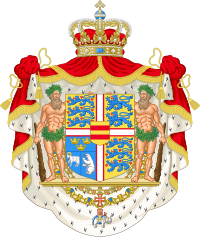
Back شعار الدنمارك Arabic Escudu de Dinamarca AST Герб Даніі Byelorussian Герб Даніі BE-X-OLD Герб на Дания Bulgarian ডেনমার্কর চিনত্হান BPY Grb Danske BS Escut de Dinamarca Catalan Státní znak Dánska Czech Danmarks rigsvåben Danish
| Greater coat of arms of Denmark | |
|---|---|
 Greater (royal) version | |
| Versions | |
 Middle version | |
 Lesser (state) version | |
| Armiger | Frederik X, King of Denmark |
| Adopted | First documented in the 1190s. Modified 1819. Designated as dynastic arms 1959. Last modified 5 July 1972 |
| Crest | Crown of King Christian V |
| Torse | tasseled strings Or |
| Shield | A shield quartered by a cross argent fimbriated gules, first and fourth quarter Or, three lions passant in pale azure crowned and armed Or langued gules, nine lily pads gules (for Denmark); second quarter Or, two lions passant in pale azure armed Or langued gules (for Schleswig); third quarter azure, party per fess, in base per pale; in chief three crowns Or (for the Kalmar Union), in dexter base a ram passant argent armed and unguled Or (for the Faroe Islands), in sinister base a polar bear rampant argent (for Greenland). Overall an escutcheon Or two bars gules (for Oldenburg) |
| Supporters | two wild men armed with clubs Proper |
| Compartment | pedestal |
| Motto | Latin: Magnanimi Pretium |
| Order(s) | Order of the Dannebrog, and Order of the Elephant |
| Other elements | The monarch places this coat of arms on a mantle gules lined with Ermine. Above the mantle is a pavilion gules again topped with the royal crown. |
| Earlier version(s) | 24 August 1815 |

The coat of arms of Denmark (Danish: Danmarks rigsvåben) has a lesser and a greater version.
The state coat of arms (rigsvåben) consists of three pale blue lions passant wearing crowns, accompanied by nine red lilypads (normally represented as heraldic hearts), all in a golden shield with the royal crown on top.
The national coat of arms of Denmark (nationalvåben — also called lille våben) is similar to the state coat of arms, but without the royal crown above the shield.
It is historically the coat of arms of the House of Estridsen, the dynasty which provided the kings of Denmark between 1047 and 1412. The current design was introduced in 1819, under Frederick VI. Previously, there had been no distinction between the "national" and the "royal" coat of arms. Since 1819, there has been a more complex royal coat of arms of Denmark (kongevåben) separate from the national coat of arms (rigsvåben).
© MMXXIII Rich X Search. We shall prevail. All rights reserved. Rich X Search